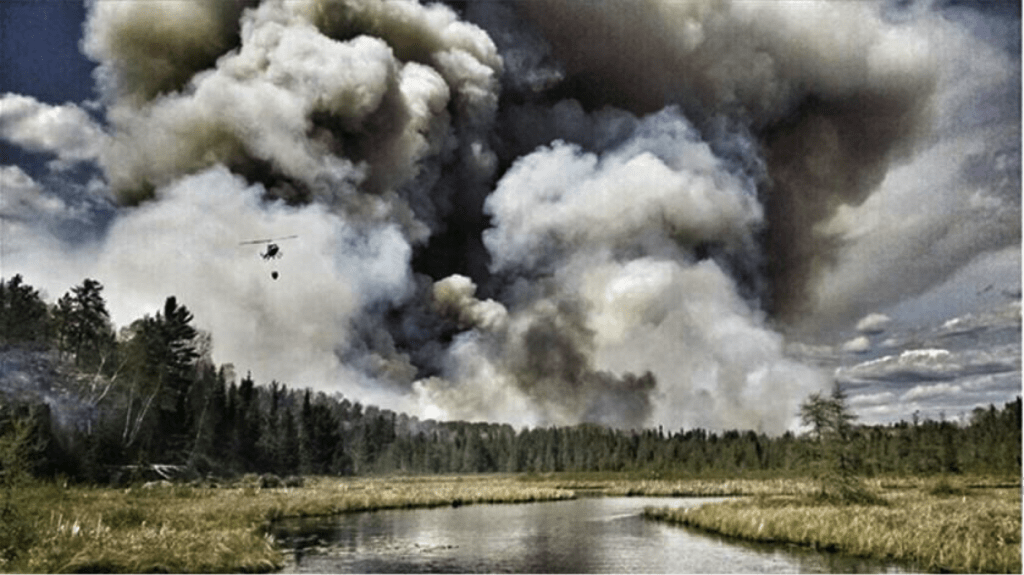
An intentional fire set by the U.S. Forest Service near Burntside Lake last May was intended to reduce the risk of wildfires in a populated area, but instead it turned into one. The Foss Lake Fire jumped containment lines and burned almost 1,000 acres of forest, most of it inside the Boundary Waters Canoe Area Wilderness, before finally being contained almost two weeks later.
Now, a new report explains how that happened (PDF download). The Forest Service analysis is not meant to assign blame – recognizing the dynamic and unpredictable nature of wildland fires – but rather provide lessons for fire managers to help prevent a repeat of the incident.
“In any complex environment, error and uncertainty persist despite our best efforts to eliminate them,” the report states. “This review takes into consideration the fundamental character of complex systems and is not a critique of ability or performance.”
Essentially, the Foss Lake Fire happened due to a combination of several factors, from incorrect weather forecasts to breakdowns in communication, and including the inability to secure backup firefighters and aircraft. Problems even extended to two water pumps that wouldn’t start at the worst possible time.
The result was the fire was declared escaped only three hours after the first flames were lit.
Too dry, too windy
The prescribed fire was meant to consume vegetation that was so dry it would be dangerous in a naturally-occurring blaze. But according to the report, those conditions ultimately contributed to the fire escaping. On the day of the burn, the fuels were drier than during the Ham Lake, Cavity Lake, and Pagami Creek fires.
Atmospheric conditions were also volatile. The air was dry and the wind picked up as the day progressed.
“In some cases, the indicated or forecasted conditions were outside the prescription—or would become outside prescription parameters later in the day,” the report reads. “Specifically, low fine fuel moisture and higher winds, especially gusts, would contribute to conditions being outside of burn parameters.”
Unfortunately, information from a remote weather station that was set up near the burn area was not used by managers. It indicated conditions were “more severe” and outside acceptable limits to ignite a fire, but managers proceeded with the plan based on forecasts and their on-the-ground observations.
Those observations were limited by the burn site’s geography. After the fire was lit, managers discovered it was windier than expected.
“The Firing Boss began to notice that even though the burn was progressing well, the wind was picking up and was very squirrely at times,” the report reads. “With this in mind, he slowed down the ignitions to minimize the spotting potential. When he proceeded down the hill toward the creek, he also noticed that the winds behind him and higher on the slope seemed to be stronger than what he was experiencing lower on the slope.”
Failures to communicate
When fires began popping up outside the prescribed burn perimeter, the response was slowed and confused by communication breakdowns.
The problems stemmed from firefighters and managers using channels other than the radio to share information, relying on cell phones and text messages, which meant different people had different information.
The analysts found that not everybody involved was aware of some decisions and conversations made throughout the day, and uninformed about elements of safety, operations, and decisions.
Turnover trouble
The report also points to inconsistent fire practices caused by staffing difficulties on the Superior National Forest.
These difficulties included “high turnover rate in key fire leadership, pilot, and ranger positions; extended vacancies and barriers, including human resource delays, challenges with the reorganization process, and a lack of applicant interest for vacant positions.”
These factors are blamed for forcing Forest Service fire personnel to do more jobs themselves, as well as causing “issues with consistency and continuity in direction, management, and oversight.”
Unreliable resources
When a small fire outside the perimeter was spotted, firefighters were nearby. They were planning to take advantage of the “endless supply of water” provided by nearby lakes, and had hoses laid and ready.
They just needed to get the water out of the lake and into the forest, but their pumps failed.
“Initially, the hose lay was to be charged with a float pump,” the report reads. “However, the crews could not successfully start the pump. A Mark 3 pump was then retrieved from another location, put in place, and attempts were made to start it. Crews could not successfully start the second pump for a critical period of time.”
That fire would ultimately spread into the main wildfire.
Then, when worries about the fire began to escalate, fire managers called for backup resources like two other Hot Shot crews in the region, and helicopters that could drop water. But the other firefighters were busy on other prescribed and wild fires, and there was confusion about the need and availability of air support.
“A Type 3 Helicopter with bucket was requested. Dispatch indicated a Type 1 Helicopter was available if needed. It was declined as not needed,” analysts reported. “Approximately 20 minutes later, the Type 1 Helicopter was requested along with an Air Attack.”
Not long after that, it was declared escaped and the prescribed burn was shut down, with personnel and resources moved to fighting the wildfire.
How this chain of events occurred is perhaps best explained by a quote from the individual in charge of the prescribed fire: “We were trying to stay ahead of when green-up would occur or we would lose the chance for the summer.”

